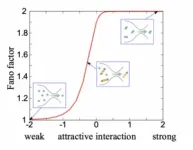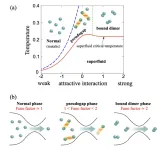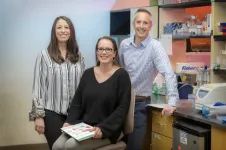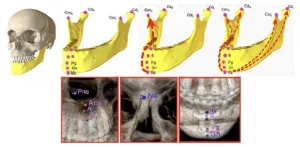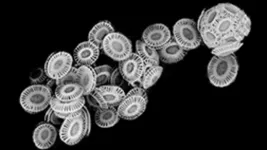(Press-News.org) Astrophysicists in Australia have shed new light on the state of the universe 13 billion years ago by measuring the density of carbon in the gases surrounding ancient galaxies.
The study adds another piece to the puzzle of the history of the universe.
“We found that the fraction of carbon in warm gas increased rapidly about 13 billion years ago, which may be linked to large-scale heating of gas associated with the phenomenon known as the ‘Epoch of Reionisation’,” says Dr Rebecca Davies, ASTRO 3D Postdoctoral Research Associate at Swinburne University of Technology, Australia and lead author of the paper describing the discovery.
The study shows the amount of warm carbon suddenly increased by a factor of five over a period of only 300 million years – the blink of an eye in astronomical timescales.
While previous studies have suggested a rise in warm carbon, much larger samples – the basis of the new study – were needed to provide statistics to accurately measure the rate of this growth.
“That's what we've done here. And so, we present two potential interpretations of this rapid evolution,” says Dr Davies.
The first is that there is an initial increase in carbon around galaxies simply because there is more carbon in the universe.
“During the period when the first stars and galaxies are forming, a lot of heavy elements are forming because we never had carbon before we had stars,” Dr Davies says. “And so one possible reason for this rapid rise is just that we're seeing the products of the first generations of stars.”
However, the study also found evidence that the amount of cool carbon decreased over the same period. This suggests that there might be two different phases in the evolution of the carbon – a rapid rise while reionisation occurs, followed by a flattening out.
The research was a collaboration between: Swinburne University of Technology; the ARC Centre of Excellence for All Sky Astrophysics in 3 Dimensions (ASTRO 3D); INAF-Osservatorio Astronomico di Trieste; IFPU-Institute for Fundamental Physics of the Universe, Trieste; Scuola Normale Superiore, Pisa; Max-Planck - Institut für Astronomie, Heidelberg, Germany; the University of California, Riverside; Leibniz Institute for Astrophysics Potsdam (AIP); MIT Kavli Institute for Astrophysics and Space Research, Gemini Observatory and NSF’s NOIRLab, Hawai’i; and the University of Cambridge.
The Epoch of Reionisation, which took place when the universe was “only” one billion years old, was when the lights came back on after the cosmic Dark Ages following the Big Bang.
Before this the universe was a dark, dense fog of gas. But as the first massive stars formed, their light began to shine through space and reionise the cosmos. This light may have led to rapid heating of the surrounding gas, causing the rise in warm carbon observed in this study.
Studies of reionisation are vital to understand when and how the first stars formed and began producing the elements that exist today. But measurements have been notoriously difficult.
“The research led by Dr Davies was built on an exceptional sample of data obtained during 250 hours of observations on the Very Large Telescope (VLT) at the European Southern Observatory in Chile,” says Dr Valentina D’Odorico from the Italian Institute for Astrophysics, the Principal Investigator of the observational programme. “This is the largest amount of observing time assigned to a single project carried out with the X-shooter spectrograph.
“Thanks to the 8m VLT we could observe some of the most distant quasars, which act as flashlights, illuminating galaxies along the path from the early Universe to the Earth."
As the quasar light passes through galaxies in its 13-billion-year journey across the universe some photons are absorbed, creating distinctive barcode-like patterns in the light, which can be analysed to determine the chemical composition and temperature of gas in the galaxies.
This gives an historical picture of the development of the universe.
“These ‘barcodes’ are captured by detectors at the VLT’s X-Shooter spectrograph,” Dr Davies explains.
“This instrument splits the galaxy light into different wavelengths, like putting light through a prism, allowing us to read the barcodes and measure the properties of each galaxy.”
The study led by Dr Davies captured more barcodes of ancient galaxies than ever before.
“We increased from 12 to 42 the number of quasars for which we had high quality data, finally allowing a detailed and accurate measurement of the evolution of the carbon density,” says Dr D’Odorico.
This major advance was enabled by the ESO VLT, one of the most advanced telescopes on Earth, and a strategic partner of Australia.
“The study provides a legacy data set which will not be significantly improved until 30m-class telescopes comes online towards the end of this decade,” says Professor Emma Ryan-Weber, a Chief Investigator in the ARC Centre of Excellence for All Sky Astrophysics in 3 Dimensions (ASTRO 3D) and second author of the study.
“High quality data from even earlier in the Universe will require access to telescopes like the Extremely Large Telescope (ELT) now under construction in Chile."
Astronomers are using many different types of data to build a history of the universe.
“Our results are consistent with recent studies showing that the amount of neutral hydrogen in intergalactic space decreases rapidly around the same time,” says Dr Davies.
“This research also paves the way for future investigations with the Square Kilometre Array (SKA) which aims to directly detect emission from neutral hydrogen during this key phase of the universe's history.”
Professor Ryan-Weber says the research goes to the heart of ASTRO 3D’s mission to understand the evolution of elements, from the Big Bang to present day.
“It addresses this key goal: how did the building blocks of life – in this case carbon – proliferate across the universe?
“As humans we strive to understand ‘where did we come from?’ It’s incredible to think that the barcode of those 13-billion-year-old carbon atoms were imprinted on photons at a time when the Earth didn’t even exist. Those photons travelled across the universe, into the VLT, and then were used to develop a picture of the evolution of the universe.”
ABOUT ASTRO 3D
The ARC Centre of Excellence for All Sky Astrophysics in 3 Dimensions (ASTRO 3D) is a $40m Research Centre of Excellence funded by the Australian Research Council (ARC) and nine collaborating Australian universities – The Australian National University, The University of Sydney, The University of Melbourne, Swinburne University of Technology, The University of Western Australia, Curtin University, Macquarie University, The University of New South Wales, and Monash University.
Contacts:
Bill Condie (Media Contact for ASTRO 3D)
Ph: +61 450 952 365 E: bill@scienceinpublic.com.au
Interviews
Rebecca Davies (ASTRO 3D, Swinburne University of Technology)
Ph: +61 405 667 019 E. rdavies@swin.edu.au
Emma Ryan-Weber (ASTRO 3D, Swinburne University of Technology)
Ph: +61 408 382 725 E. eryanweber@swin.edu.au
The paper is available at: https://doi.org/10.1093/mnras/stad294
Examining the Decline in the C IV Content of the universe over 4.3 ≲ z ≲ 6.3 using the E-XQR-30 Sample
Rebecca L. Davies1,2⋆, E. Ryan-Weber1,2, V. D’Odorico3,4,5, S. E. I. Bosman6, R. A. Meyer6,
G. D. Becker7, G. Cupani3, L. C. Keating8, M. Bischetti3, F. B. Davies6, A.-C. Eilers9,
E. P. Farina10, M. G. Haehnelt11,12, A. Pallottini5, Y. Zhu7
1Centre for Astrophysics and Supercomputing, Swinburne University of Technology, Hawthorn, Victoria 3122, Australia 2ARC Centre of Excellence for All Sky Astrophysics in 3 Dimensions (ASTRO 3D), Australia
3INAF-Osservatorio Astronomico di Trieste, Via Tiepolo 11, I-34143 Trieste, Italy
4IFPU-Institute for Fundamental Physics of the universe, via Beirut 2, I-34151 Trieste, Italy
5Scuola Normale Superiore, Piazza dei Cavalieri 7, I-56126 Pisa, Italy
6Max-Planck-Institut fu ̈r Astronomie, Ko ̈nigstuhl 17, D-69117 Heidelberg, Germany
7Department of Physics & Astronomy, University of California, Riverside, CA 92521, USA
8Leibniz Institute for Astrophysics Potsdam (AIP), An der Sternwarte 16, D-14482 Potsdam, Germany
9MIT Kavli Institute for Astrophysics and Space Research, 77 Massachusetts Ave., Cambridge, MA 02139, USA 10Gemini Observatory, NSF’s NOIRLab, 670 N A’ohoku Place, Hilo, Hawai’i 96720, USA
11Institute of Astronomy, University of Cambridge, Madingley Road, Cambridge CB3 0HA, UK
12Kavli Institute for Cosmology, University of Cambridge, Madingley Road, Cambridge CB3 0HA, UK
NASA Hubble Fellow
25 January 2023
ABSTRACT
Intervening C iv absorbers are key tracers of metal-enriched gas in galaxy halos over cosmic time. Previous studies suggest that the C iv cosmic mass density (ΩC iv) decreases slowly over 1.5 ≲ z ≲ 5 before declining rapidly at z ≳ 5, but the cause of this downturn is poorly understood. We characterize the ΩC iv evolution over 4.3 ≲ z ≲ 6.3 using 260 absorbers found in 42 XSHOOTER spectra of z ∼ 6 quasars, of which 30 come from the ESO Large Program XQR-30. The large sample enables us to robustly constrain the rate and timing of the downturn. We find that ΩC iv decreases by a factor of 4.8 ± 2.0 over the ∼ 300 Myr interval between z ∼ 4.7 and z ∼ 5.8. The slope of the column density (log N ) distribution function does not change, suggesting that C iv absorption is suppressed approximately uniformly across13.2⩽logN/cm−2 <15.0.Assumingthatthecarboncontentofgalaxyhalosevolvesastheintegralofthe cosmic star formation rate density (with some delay due to stellar lifetimes and outflow travel times), we show that chemical evolution alone could plausibly explain the fast decline in ΩC iv over 4.3 ≲ z ≲ 6.3. However, the C iv/C ii ratio decreases at the highest redshifts, so the accelerated decline in ΩC iv at z ≳ 5 may be more naturally explained by rapid changes in the gas ionization state driven by evolution of the UV background towards the end of hydrogen reionization.
Key words: quasars: absorption lines – intergalactic medium – early universe
END
Tracing 13 billion years of history by the light of ancient quasars
New evidence for rapid heating in the early universe
2023-03-07
ELSE PRESS RELEASES FROM THIS DATE:
Wings, not webs: Certain bugs are the winners of urbanization, impacting cities’ insect diversity
2023-03-07
Cities are bursting with life, both human and animal. The smallest of them, insects, spiders, and ants are easily overseen, but their presence – or absence – in cities has wide-reaching effects. Scientists in Austria have published a study in Frontiers in Ecology and Evolution, which found a correlation between the presence of arthropods – invertebrate animals with an exoskeleton; among them are bees, insects, and spiders – and level of urbanization.
“We show that richness and diversity of arthropods on trees and bushes decreases along the rural-urban gradient,” said first author Dr Marion Chatelain, a postdoctoral ...
Quantum crossover: How to distinguish single-particle and pair currents
2023-03-07
If you cool down low-density atomic gas to ultralow temperatures (−273°C), you get a new state of matter called the Bose-Einstein Condensate (BEC). A BEC has strongly coupled two-atom molecules behaving like a collective wave following quantum mechanics. Now if you reduce the pairing strength between them—for example, by increasing the magnetic field—the atoms form “Cooper-pairs” according to Bardeen-Cooper-Schrieffer (BCS) theory—a Nobel Prize winner. The process is called BCS-BEC crossover. And the theory forms the basis ...
Females of all ages, sexes have more salt- sensitive hypertension than males
2023-03-07
There is increasing evidence that females of all ethnicities and ages are more salt sensitive than males, and that this propensity to hold onto more salt, which drives blood pressure up, increases after menopause.
Another important emerging bottom line is that healthy blood pressures might differ between the sexes, which means females might benefit from earlier and different intervention to avoid damage to their heart and vasculature.
“The realities are that women and men regulate our blood pressure differently and our blood pressures are different at baseline,” says Dr. Eric Belin de Chantemele, physiologist in the Vascular Biology Center at the Medical College of Georgia at ...
Mass General Brigham study finds virtual care team strategy improved treatment for heart failure patients
2023-03-06
Recent studies have provided strong evidence that patients with heart failure can benefit from medical therapies that can reduce risk of worsening symptoms and extend patients’ lives. But, despite new guidelines, adoption of these therapies has been slow, incomplete and inequitable. A prospective clinical study by investigators from Mass General Brigham evaluated a new approach to improve use of these therapies by putting in place a virtual care team, consisting of physicians and pharmacists, to help guide treatment strategies for patients seeking care at three Mass General Brigham hospitals: Brigham and Women’s Hospital (BWH), Brigham and Women’s Faulkner Hospital ...
Deep-learning-based anatomical landmark identification in CT scans
2023-03-06
Millions of people around the world undergo some type of orthodontic treatment each year due largely to developmental deformities in the jaw, skull, or face. Computed tomography (CT) imaging is the go-to technique for surgeons when planning such treatments, especially surgeries. This is because CT provides 3D images of the bones and teeth, which helps the surgeon analyze complex cases in detail and determine the best treatment procedure based on that.
During the CT scan, surgeons typically try to pinpoint specific anatomical landmarks in the images. These are distinct points in the human body that can be used as a reference to make measurements and assess a condition ...
The challenges of mining for electric-vehicle batteries
2023-03-06
In August 2022, Congress passed the Inflation Reduction Act (IRA). Signed by President Joe Biden, the legislation attempted to curb inflation, lower the deficit, and invest heavily into domestic clean energy.
One aspect of the bill was setting a market value-based target for battery-critical mineral content in electric vehicles (EVs). By 2027, for an EV to be tax-credit eligible, 80 percent of the market value of critical minerals in its battery must be extracted or processed domestically or by US free-trade partners (FTPs).
While this goal is well-intended, there are reasons to believe the mandate is unreachable and could create new problems.
In a commentary published ...
AI chatbot ChatGPT mirrors its users to appear intelligent
2023-03-06
LA JOLLA (March 6, 2023)—The artificial intelligence (AI) language model ChatGPT has captured the world’s attention in recent months. This trained computer chatbot can generate text, answer questions, provide translations, and learn based on the user’s feedback. Large language models like ChatGPT may have many applications in science and business, but how much do these tools understand what we say to them and how do they decide what to say back?
In new paper published in Neural Computation on February 17, 2023, Salk Professor Terrence Sejnowski, ...
Advancing engineering
2023-03-06
(Santa Barbara, Calif.) — UC Santa Barbara professors Thuc-Quyen Nguyen and Carlos G. Levi are among 106 new members of the National Academy of Engineering. Academy membership honors those who have made outstanding contributions to “engineering research, practice or education, including, where appropriate, significant contributions to the engineering literature” and to “the pioneering of new and developing fields of technology, making major advancements in traditional fields of engineering, or developing/implementing innovative approaches to engineering education.”
“Our campus ...
Microscopic chalk discs in oceans play a key role in earth’s carbon cycle by propagating viruses
2023-03-06
A Rutgers-led team of scientists studying virus-host interactions of a globally abundant, armor-plated marine algae, Emiliania huxleyi, has found that the circular, chalk plates the algae produce can act as catalysts for viral infection, which has vast consequences for trillions of microscopic oceanic creatures and the global carbon cycle.
“In a drop of seawater, there will be about 1,000 to 10,000 E. huxleyi cells, and about 10 million viruses,” said Kay Bidle, a professor in the Department of ...
WVU water quality expert develops public tool for diagnosing health of America’s streams
2023-03-06
A model for predicting the levels of oxygen in water, developed by West Virginia Universityresearcher Omar Abdul-Aziz, gives citizen scientists nationwide a tool for taking action on stream pollution.
“I have been looking at water quality data for 20 years,” said Abdul-Aziz, an associate professor at the Benjamin M. Statler College of Engineering and Mineral Resources. “I can tell you that a big percentage of streams in the United States are polluted. Urban streams are getting dumpster runoff, stormwater ...
LAST 30 PRESS RELEASES:
Heart-brain connection: international study reveals the role of the vagus nerve in keeping the heart young
Researchers identify Rb1 as a predictive biomarker for a new therapeutic strategy in some breast cancers
Survey reveals ethical gaps slowing AI adoption in pediatric surgery
Stimulant ADHD medications work differently than thought
AI overestimates how smart people are, according to HSE economists
HSE researchers create genome-wide map of quadruplexes
Scientists boost cell "powerhouses" to burn more calories
Automatic label checking: The missing step in making reliable medical AI
Low daily alcohol intake linked to 50% heightened mouth cancer risk in India
American Meteorological Society announces Rick Spinrad as 2026 President-Elect
Biomass-based carbon capture spotlighted in newly released global climate webinar recording
Illuminating invisible nano pollutants: advanced bioimaging tracks the full journey of emerging nanoscale contaminants in living systems
How does age affect recovery from spinal cord injury?
Novel AI tool offers prognosis for patients with head and neck cancer
Fathers’ microplastic exposure tied to their children’s metabolic problems
Research validates laboratory model for studying high-grade serous ovarian cancer
SIR 2026 delivers transformative breakthroughs in minimally invasive medicine to improve patient care
Stem Cell Reports most downloaded papers of 2025 highlight the breadth and impact of stem cell research
Oxford-led study estimates NHS spends around 3% of its primary and secondary care budget on the health impacts of heat and cold in England
A researcher’s long quest leads to a smart composite breakthrough
Urban wild bees act as “microbial sensors” of city health.
New study finds where you live affects recovery after a hip fracture
Forecasting the impact of fully automated vehicle adoption on US road traffic injuries
Alcohol-related hospitalizations from 2016 to 2022
Semaglutide and hospitalizations in patients with obesity and established cardiovascular disease
Researchers ‘listen in’ to embryo-mother interactions during implantation using a culture system replicating the womb lining
How changing your diet could help save the world
How to make AI truly scalable and reliable for real-time traffic assignment?
Beyond fragmented markets: A new framework for efficient and stable ride-pooling
Can shape priors make road perception more reliable for autonomous driving?
[Press-News.org] Tracing 13 billion years of history by the light of ancient quasarsNew evidence for rapid heating in the early universe

